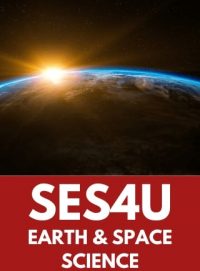SES4U - Grade 12 Earth and Space Science (Upgrade) Online

Course Description For SES4U Grade 12 Earth and Space Science (Upgrade) Online Course
Grade 12 Earth and Space Science takes an in-depth look at our amazing planet Earth and its place in the universe. Throughout the course, students will investigate the properties and forces of our solar system and analyse some of the techniques scientists use to generate knowledge about them. In doing so, students will examine Earth’s basic materials, its geological history, and how its systems interact and change over time.
SES4U Course Outline and Timeline
Below is the suggested sequence of course unit delivery as well as the recommended number of hours to complete the respective unit. For complete details of targeted expectations within each unit and activity, please see each Unit Overview found in the SES4U course profile.
| Unit Order | Unit Name | Suggested Time |
|---|---|---|
| Unit 1 | Astronomy and Planetary Science | 25 Hours |
| Unit 2 | Earth’s Geological History | 25 Hours |
| Mid Semester Point | ||
| Unit 3 | Earth Minerals | 25 Hours |
| Unit 4 | Geological Process | 25 Hours |
| Summative | Final Summative Assignment | 8 Hours |
| FINAL | Final Exam | 2 Hours |
| View Sample Gradebook Total | 110 Hours | |
Please be aware that, as per Ministry guidelines, OVS has a mandatory minimum requirement of 11 days enrollment for students to be eligible for a midterm report card and 21 days enrollment to be eligible for a final report card in repeat/upgrade courses.
Fundamental Concepts Covered in Earth & Space Upgrade Courses Online Course
This course enables students to deepen their understanding of Earth and Space Science concepts and theories. They will further develop their scientific investigation skills, learning, for example, how to analyse, qualitatively and quantitatively, data related to a variety of Earth and Space Science concepts and principles. Students will also consider the impact of technological applications of Earth and Space Science on society and the environment.
Online Teaching and Learning Strategies
Teachers will bring enthusiasm and varied teaching and assessment approaches to the classroom, addressing individual students’ needs and ensuring sound learning opportunities for every student. The activities offered should enable students to relate and apply these concepts to the social, environmental, and economical conditions and concerns of the world in which they live. Opportunities to relate knowledge and skills to these wider contexts will motivate students to learn in a meaningful way and to become life-long learners. Teachers will to help students understand that problem solving of any kind often requires a considerable expenditure of time and energy and a good deal of perseverance. Teachers also will encourage students to investigate, to reason, to explore alternative solutions and to take the risks necessary to become successful problem solvers. Effective instructional approaches and learning activities draw on students’ prior knowledge, capture their interest, and encourage meaningful practise both inside and outside the classroom. Students will be engaged when they are able to see the connection between the scientific concepts they are learning and their application in the world around them and in real-life situations. Due to its importance, students will have opportunities to learn in a variety of ways- individually, cooperatively, independently, with teacher direction, through hands-on experiences, and through examples followed by practice. The approaches and strategies teachers use will vary according to both the object of the learning and the needs of the students. Teachers will accomplish this in an online environment with the use of virtual labs, online simulation, animations, videos, discussion forums, live chat, and other interactive objects.
Assessment & Evaluation
As summarized in Growing Success 2010, the primary purpose of assessment and evaluation is to improve student learning. Information gathered through assessment helps teachers to determine students’ strengths and weaknesses and adapt curriculum and instructional approaches accordingly.
As part of assessment, teachers provide students with descriptive feedback to help guide their learning Evaluation refers to the process of measuring the quality of work against an established criteria, and assigning a value representative of work quality. All curriculum expectations must be accounted for in instruction, but evaluation focuses on students’ achievement of the overall expectations.
A students’ achievement is evaluated in relation to specific expectations. Teachers use their professional judgement to determine which specific expectations should be used to evaluate achievement of overall expectations, and which ones will be covered in instruction and assessment but not used as an evaluation benchmark. To ensure assessment and evaluation are valid and fair teachers use assessment and evaluation strategies that:
- Address both what students learn and how well they learn
- Are based on the achievement level descriptions given in the achievement chart
- Are varied in nature, administered over time, and designed to provide opportunities for students to demonstrate the full range of their learning
- Are appropriate for the learning activities used, the purposes of instruction, and the needs and experiences of the students
- Are fair to all students
- Accommodate students with special education needs, consistent with the strategies outlined in their Individual Education Plan
- Accommodate the needs of students who are learning the language of instruction
- Ensure that each student is given clear directions for improvement
- Promote students’ ability to assess their own learning and to set specific goals
- Include student work samples as evidence their achievement
- Are communicated clearly to students and parents at the beginning of the school year and at other appropriate points throughout the school year.
The achievement chart outlines four categories of knowledge and skills:
- Knowledge and understanding
- Critical thinking
- Communication
- Application
Teachers assess and/or evaluate work in a balanced manner with respect to the four categories. A final grade is recorded, and a credit is granted and recorded for this course if the student’s grade is 50% or higher. The final grade for this course will be determined as follows:
Seventy percent of the grade is based on evaluations conducted throughout the course. This portion of the grade reflects the student’s most consistent level of achievement throughout the course, although special consideration should be given to more recent evidence of achievement.
Thirty percent of the grade is based on a final evaluation and administered towards the end of the course.
Special Accommodations for Students with an IEP
Every single student is capable of success. Some students are able, with certain accommodations, to participate in the regular course curriculum and demonstrate independent learning.
Accommodations allow access to the course without any changes to the knowledge and skills the student is expected to demonstrate. The accommodations required to facilitate the student’s learning are identified by the teacher. Recommendations from a School Board generated Individual Education Plan (IEP) if available can also be consulted. Instruction based on principles of universal design and differentiated make it possible to meet the diverse needs of all learners.
Examples of accommodations (but not limited to) include:
- Adjusting or extending assessment deadlines
- Providing alternative assignments or summative tasks
- Use of scribes and/or other assistive technologies
- Simplifying the language of instruction
Resources
Teachers will bring additional resources and teaching materials that provide a rich and diverse learning environment. Units in this course profile make specific reference to the intended textbook for this course but can be substituted for any relevant and approved text.
- Gizmos! ExploreLearning. Web. 16 June 2010.
- “PhET: Free Online Earth and Space Science, Chemistry, Biology, Earth Science and Math Simulations.” Web. 17 June 2010.
Reference: Science, The Ontario Curriculum, Grades 11 and 12, 2008 (Revised) Ministry of Education of Ontario
Ontario Secondary School Diploma (OSSD) Requirements for all course.
Frequently Asked Questions
What is SES4U?
SES4U is a Grade 12 Earth and Space Science course at a University preparation level.
What are 4U courses?
4U refers to the Grade level of the courses and the pathway. 4 means it is a grade 12 course and U means it is a university preparation course.
What is the Prerequisite Course for SES4U?
Prerequisite: Documentation showing you have successfully passed this course before
Click here for more information on Ontario secondary curriculum and their prerequisites
How Long Does it take to Complete the SES4U Online Course?
At Ontario Virtual School (OVS) you can complete an online high school credit courses as quickly as 4 weeks, or take as long as 12 months. Self-paced learning is one of the many benefits of the Ontario Virtual School.
Student & Parent Recommendations
Google Reviews for SES4U - Grade 12 Earth and Space Science (Upgrade)





